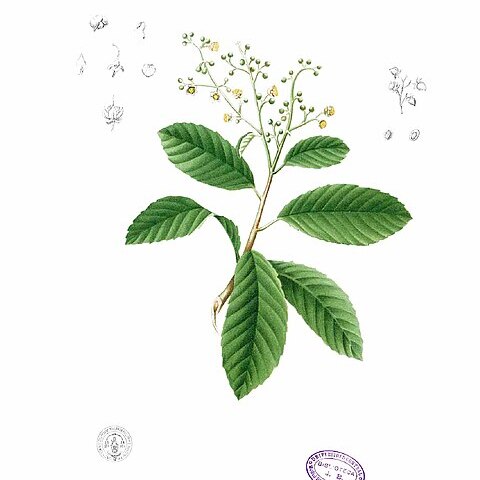Evergreen woody climbers to 30 m. Young branchlets densely pubescent, glabrescent. Petiole 1-1.5 cm, pubescent; leaf blade ovate or obovate, 4-10 × 2.5-5 cm, leathery, scabrous, abaxially brown hispid, scaberulose, adaxially sparsely setose, with strumose protuberance, secondary veins 9-12, approximately parallel, obviously prominent on abaxial surface, slightly depressed on adaxial surface, veinlets unclear, base rounded, often oblique, apex rounded or obtuse, sometimes slightly acute. Panicles terminal, 10-20 cm, many flowered; peduncle and pedicels pubescent; bracts lanceolate, 4-6 mm, hairy; bractlets linear-lanceolate, 2-3 mm, hairy. Flowers 6-8 mm in diam. Sepals 4 or 5, ovate, 3-4 mm, abaxially pubescent, persistent in fruit, slightly curved, apex rounded. Petals 3, white, slightly longer than sepals, deciduous. Stamens numerous, as long as sepals. Carpels 1(or 2), densely gray pubescent; ovules several. Follicles ovate, ca. 1 cm, apex with persistent bent beaklike style, ± pubescent. Seeds 1 or 2, 3-4 mm; aril fringed, enclosing base of seeds.
More
Liana (up to 30 m) or small shrub (up to 2 m). Leaves oblong to obovate, ca 6-15 by 3-7 cm, scabrid, apex and base rounded to obtuse. Petiole ca 6-12 mm. Inflorescence terminal, many-(up to ca 200)-flowered, with in the basal part 1-5 leaves, up to ca 40 by 20 cm. Flower ca 6-8 mm diam. Sepals 4, on the same plant in some (ca 5 %) of the flowers 5, ca 3 by 2 mm, scabrid outside. Petals 3. Stamens 3 mm long; Anthercells reaching each other at the apex. Carpels with 0.4-0.7 mm long rigid hairs; ovules ca 10. Capsule ovoid, ca 10 by 6 mm, 1(-2)-seeded. Seeds 4 by 3 mm. Aril 2-3 mm long, fimbriate for ¾-9/10 of its length.
A woody vine. The leaves are very rough, alternate and pointed at both ends but longer near the tip than the base. They are toothed around the edge and the surface is rough. The flowers are rather small and white and borne on compound flower arrangements. The fruit are small and red.
A creeper or climber in thickets and secondary forests, especially on riverbanks and near the seacoast; in more open vegetation forming small shrubs. Found at elevations from sea-level up to 1,000 metres, but rarely above 500 metres.
More
Creeper or climber in thickets and secondary forests, especially on riverbanks and near the seacoast; in more open vegetation forming small shrubs. From sea-level up to 1000 m, rarely above 500 m.
A tropical plant. Apparently common and widely distributed from central Luzon to southern Mindanao in the Philippines in dry forests. In Yunnan.

